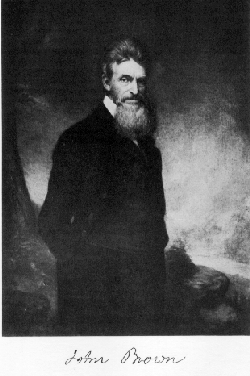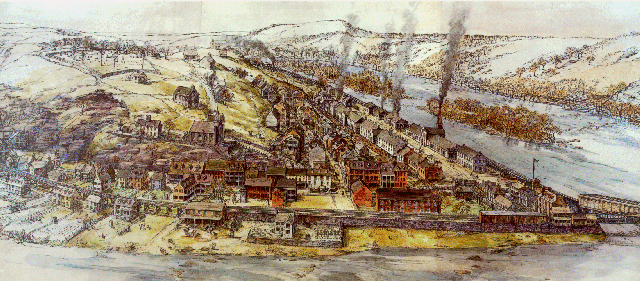 John Brown saw himself as a God-sent liberator to wipe out slavery in the American South. Following his raid in Kansas in 1856, he had been devising a plan to purify the entire South through an armed slave rebellion that he would lead. Brown believed that "without shedding of blood there is no remission of sins" (MacPherson, 117). Also, with all of the recent victories for southern slave-holders (Kansas-Nebraska Act, Dred Scott decision, etc.), Brown thought that "violent counterstroke was the only answer" (Ibid., 117).
John Brown saw himself as a God-sent liberator to wipe out slavery in the American South. Following his raid in Kansas in 1856, he had been devising a plan to purify the entire South through an armed slave rebellion that he would lead. Brown believed that "without shedding of blood there is no remission of sins" (MacPherson, 117). Also, with all of the recent victories for southern slave-holders (Kansas-Nebraska Act, Dred Scott decision, etc.), Brown thought that "violent counterstroke was the only answer" (Ibid., 117).
Brown persuaded many abolitionists to support his ideas, and attempted to recruit Frederick Douglas into his effort. Douglass, the night before Brown’s raid on Harper’s Ferry, failed in an attempt to persuade Brown not to go forward with the plan to capture the Federal arsenal at Harper’s Ferry, Virginia (now West Virginia), seize all the weapons there, and arm thousands of slaves who were to join him. Brown recruited 17 white and five black men to comprise his "army."
 On Oct. 16, 1859, Brown and his men captured the unguarded arsenal, but then seemed to have no alternate plan for the next step. He waited for the legions of slaves to join him, but because he had sent out little word to them, only a handful actually showed up. News of the arsenal’s capture spread rapidly, and during the night of Oct. 17-18, Brown’s men were surrounded by marines commanded by Robert E. Lee (left photo) and J.E.B. Stuart. Brown refused to surrender, and the marines stormed the building resulting in a battle leaving three locals, two of Brown's sons and twelve others dead. Brown was sentenced to death and his attempt to start a rebellion had failed.
On Oct. 16, 1859, Brown and his men captured the unguarded arsenal, but then seemed to have no alternate plan for the next step. He waited for the legions of slaves to join him, but because he had sent out little word to them, only a handful actually showed up. News of the arsenal’s capture spread rapidly, and during the night of Oct. 17-18, Brown’s men were surrounded by marines commanded by Robert E. Lee (left photo) and J.E.B. Stuart. Brown refused to surrender, and the marines stormed the building resulting in a battle leaving three locals, two of Brown's sons and twelve others dead. Brown was sentenced to death and his attempt to start a rebellion had failed.
However, Brown did not fail to provoke a violent uprising. His raid was one of many causes leading directly to the Civil War. It was the first nationally publicized uprising and after his execution, those who believed him a saint now saw him as a martyr. His death provided impetus for abolitionists in the North to rally and gain strength.
Source Used: Ordeal By Fire, James MacPherson, 1991.

 John Brown saw himself as a God-sent liberator to wipe out slavery in the American South. Following his raid in Kansas in 1856, he had been devising a plan to purify the entire South through an armed slave rebellion that he would lead. Brown believed that "without shedding of blood there is no remission of sins" (MacPherson, 117). Also, with all of the recent victories for southern slave-holders (
John Brown saw himself as a God-sent liberator to wipe out slavery in the American South. Following his raid in Kansas in 1856, he had been devising a plan to purify the entire South through an armed slave rebellion that he would lead. Brown believed that "without shedding of blood there is no remission of sins" (MacPherson, 117). Also, with all of the recent victories for southern slave-holders ( On Oct. 16, 1859, Brown and his men captured the unguarded arsenal, but then seemed to have no alternate plan for the next step. He waited for the legions of slaves to join him, but because he had sent out little word to them, only a handful actually showed up. News of the arsenal’s capture spread rapidly, and during the night of Oct. 17-18, Brown’s men were surrounded by marines commanded by
On Oct. 16, 1859, Brown and his men captured the unguarded arsenal, but then seemed to have no alternate plan for the next step. He waited for the legions of slaves to join him, but because he had sent out little word to them, only a handful actually showed up. News of the arsenal’s capture spread rapidly, and during the night of Oct. 17-18, Brown’s men were surrounded by marines commanded by